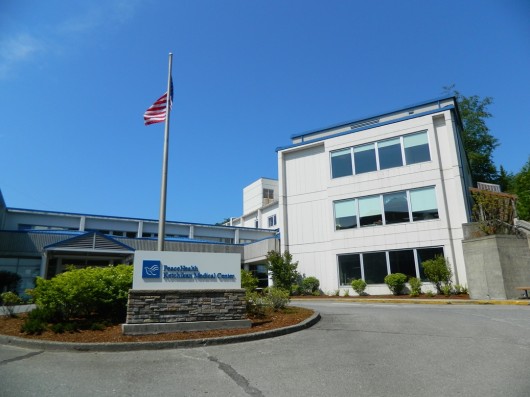Ketchikan Medical Center was the central theme of Thursday’s Ketchikan City Council meeting, along with some public comment about the ongoing chloramine water disinfection controversy.
Phase one of the long-planned hospital remodel project is about to start, and as with every big construction project – especially those that will take place on the primary road in the middle of the busy summer tourism season — there have been concerns about the impact.
Jim Quick, project manager with Dawson Construction, talked to the Ketchikan City Council during public comment about how his company plans to minimize that impact. He said the only closures will be a parking lane and the sidewalk right next to the hospital.
“One thing I want to make sure everyone is aware of is the norm is that we are not going to be impacting traffic along Tongass Avenue at all,” he said. “All three lanes, both directions and turn lane, will not be impacted during normal operations of the project.”
Quick said there will be some moments during the project when vehicle traffic will be affected because of utility work, for example, but they will be of short duration.
“And we’ll be making every effort to time that on off hours, and periods of low traffic flow, and does not affect busy times of traffic,” he said.
Also related to the hospital expansion project is the relocation of the Ketchikan Alcohol Rehabilitation facility, also called KAR House. The facility is run by Akeela, Inc., a nonprofit that also operates the former city-run Gateway Center for Human Services.
The Ketchikan City Council unanimously approved an agreement with Akeela and PeaceHealth, which operates the city-owned hospital building. In that agreement, PeaceHealth will donate a Washington Street building for use as the rehab center, plus $100,000 to help with remodeling. The city will provide $300,000 toward remodeling the property, and – after an amendment suggested by Council Member Matt Olsen – will waive the usual permit processing fees.
Akeela will pay the balance of the estimated $750,000 remodel. The move is needed because the current KAR House is in the way of the planned hospital expansion.
Following an executive session to talk about title issues related to the hospital, the Council approved a motion to apply for a zoning permit to obtain clear title for part of the property that is in question. They also approved several contracts moving the hospital remodel project forward.
While the issue wasn’t on the agenda, three people spoke during public comment about the city’s plans to start chloramine water disinfection. Bill Hardy said he respects the Council’s commitment to the community, but he doesn’t think the city made the right choice.
“I have listened, researched, become informed, assessed the options and have arrived at my own informed decision on this issue,” he said. “This is my opinion, advice and counsel to you, the mayor, management and Council. I do not think that the city has made its case to introduce chloramine to treat our water.”
Sally Balch told the Council that she and her mother are both allergic to ammonia. And MJ Cadle expressed concern for how the switch will affect people, such as herself and her granddaughter, who are sensitive to chemicals.
Chloramine is a mixture of chlorine and a small amount of ammonia. The city uses chlorine as the primary disinfectant now, but because of high levels of regulated byproducts in Ketchikan’s water, the federal Environmental Protection Agency is requiring that the city make some kind of change.
During Council comments at the end of the meeting, Council Member Marty West addressed the issue. She said she’s concerned that people are so fearful about the switch, and she wants them to know that the Council made the best choice available, based on science.
“I want people to know that we have been listening to their concerns about the chloramine situation,” she said. “We did a lot of work when we were preparing to decide what method to do, because we had to do something according to a federal mandate. We looked at a lot of different options, and this one was the best. It’s proven science. We haven’t taken a cavalier approach to this.”
The Council has been working toward the switch to chloramine for about 10 years.






